|
Introduction
Not
long
ago,
frequent
contributor
Jelena
Hahl-Fontaine
(see
her bio
below)
suddenly
felt
she
should
type
for me
the
astonishing
text
that
follows:
Not
long
after
Kandinsky's
death,
his
kindred
spirit
gave
Kandinsky's
close
friends
an
especially
personal
window
onto
their
bond
and
affinities
from
1908
until
Kandinsky's
death
in
1944.
Jelena
prefaced
the
text
she
sent
me:
"Hartmann's
English
is not
quite
perfect;
I typed
it
exactly
from
the
manuscript
as I
received
it from
Olga
[Hartmann's
wife]
in
1974…
At the
beginning
of the
text,
it's
quite
interesting
to read
about
the
difficulties
they
had in
the
early
days…
And
Hartmann's
observations
as a
close
friend
are
important…
Sending
this
just so
this
authentic
text
will
not be
forgotten
…
Much
love
from
Jelena."
The
intimacy
of
Hartmann's
account,
compounded
by the
generosity
of
Jelena's
gesture,
shook
me. I
replied:
"From
Kandinsky's
deathbed
in
1944,
Hartmann's
account;
then
given
by
Hartmann's
wife,
Olga,
to you
in
1974,
and by
you to
me in
2022.
This is
probably
the
closest
I will
ever be
to
Kandinsky
himself,
it made
me
cry—I
felt as
if I
were in
his
room.
So I
want to
thank
you. It
is such
a
privilege
to have
this
text,
and
which
you
typed
for me
yourself."
Note
that
our
October
2020
entry,
"Kandinsky
and His
Closest
Friend"—
also
about
Hartmann—can
be read here.
Jelena
has
added
illustrations
of some
of the
paintings
Hartmann
mentions,
for
your
pleasure.
From
Kandinsky's
own
last
room to
readers
of this
"Kandinsky
Anew"
Series,
I wish
you a
Happy
New
Year.
Lissa Tyler Renaud
Oakland, California
*
ABOUT KANDINSKY: BY THOMAS DE HARTMANN
(New York, 1944/45)
One
evening
after
the
death
of
Kandinsky,
several
of his
friends
found
themselves
together
to
remember
the
departed.
Among
them
was
Thomas
de
Hartmann,
the
composer,
who was
his
oldest
friend
and had
known
Kandinsky
for 40
years.
Everyone
turned
to him
to
speak
about
the
great
painter.
There
are a
good
many
elderly
people
who can
be
described
as
having
a clear
mind,
or a
great
sense
of the
past,
or a
rich
store
of
experience.
But
there
are
others,
certainly
more
rare
who, if
they do
not
actually
stay
young,
do seem
to
retain
a
quality
of
youth,
of
those
wonderful
years
known
to all
artists:
The
years
in
which
the
youthful
search
reaches
the
moment
of
spiritual
fruition,
the
moment
of
conscious
movement
forward.
My
friend
Kandinsky
was
this
kind of
man.
Until
the
last
days of
his
life he
seemed
to
remain
just as
he was
when we
met in
1908.
Nature
gave
him the
gift of
a great
life-force,
which
he did
not
waste.
Not
until
he was
past
70, and
not
until
the
second
World
War
with
all its
hardships
and
problems
overwhelmed
him did
he
begin
to
decline.
I would
like to
tell
you
about
this
man,
who was
loved
by all
who
knew
him,
and for
whom he
has not
died,
as he
has
remained
alive
to the
rest of
the
world
through
the art
he left.
I met
him
first
in
Munich.
I was
twenty-two
and
went
there
to
study
with
Felix
Mottl,
the
famous
conductor
and
pupil
of
Wagner,
although
by then
I
already
had two
large
works
for the
stage
performed
at the
Imperial
Theatre
in St.
Petersburg.
But it
didn't
take me
long to
feel
strongly
that,
although
all
concerts
were of
a high
standard
of
performance,
music
in
Germany
had
reached
an
impasse.
The
"four
B's"
reigned
[Bach,
Beethoven,
Brahms,
Bruckner]
and
Wagner's
warning,
"Children,
new and
new and
always
new,
otherwise
the
devil
of
unproductivity
will
take
you"
had
been
forgotten.
It
seemed
clear
to me
that
new
forms
and
techniques
had to
be
found,
and
more
than
anything
else I
wished
to find
my own
way.
Soon I
found
it
through
painting.
At that
time I
met two
Russian
avant-garde
painters,
Mme.
Werefkina
and
Jawlensky.
They
taught
me to
like
and
understand
van
Gogh,
Gauguin
and
Cézanne,
whose
pictures
were
just
then
being
exhibited
in
Munich.
Also
about
this
time I
met
Vassily
Kandinsky
in the
house
of
these
friends.
I
remember,
soon
after
this
first
meeting,
a hot
summer
day
when I
met
Kandinsky
unexpectedly
near
Munich's
Arch of
Triumph.
He
jumped
from
his
bicycle,
and we
began
to
speak
about
our
common
interests,
such as
metaphysics,
theatre
and the
ballet.
We
decided
to meet
the
very
same
evening
to
continue
our
talk.
This
was the
beginning
of our
great
friendship
which
lasted
until
his
death.
Kandinsky
had
then
just
come
back to
Munich
after
many
years
of
travelling
and as,
coincidentally,
his
apartment
was on
the
same
quiet
Ainmillerstreet
where I
lived,
we
began
to see
each
other
practically
every
evening.
War and
revolution
separated
us, but
later
we met
in
Paris.
I
became
acquainted
with
his
works
as they
were
taken
one by
one
from
their
packing
cases
by his
faithful
agent.
First
to be
unpacked
were
woodcuts
(Ksylographs).
I liked
them
all.
They
belonged
to a
comparatively
early
period,
when
subject
matter
was
still
there.
But I
liked
one
especially:
bright
sunshine,
a
strong
wind
moving
wash
hung on
a line.
And
this
strong
wind,
this
fluttering
wash on
the
line,
all
these
movements
were
wonderfully
expressed
through
the
play of
colours.
I knew
already
how to
appreciate
in a
picture
colour
and the
play of
lines.
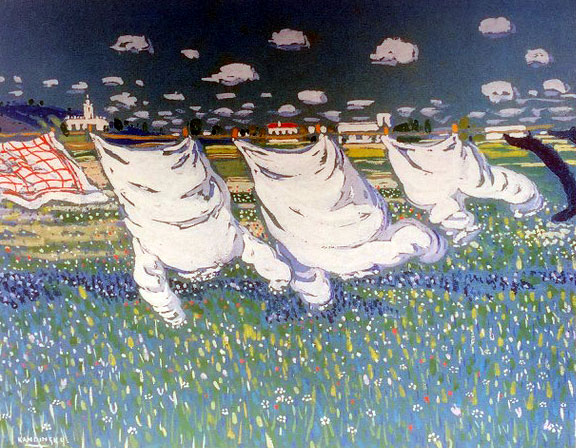
The objects themselves appeared, so to say, later. In general, subject matter
did not interest me any more. And here I was struck by this little woodcut
[sic, tempera]—how the movement continued to flow, to live, to be
dynamic in spite of having become static by being impressed on wood. I
found later that this unusual color-linear dynamism was one of the
characteristics of Kandinsky's work.
I also saw sketches for his big compositions. Usually these sketches were
simple pieces of paper on which were roughly pointed out the outlines of
images, objects, and figures. Toward them went curving lines, showing the
direction of the movement. These were dynamic outlines which were
developed later into pictures.
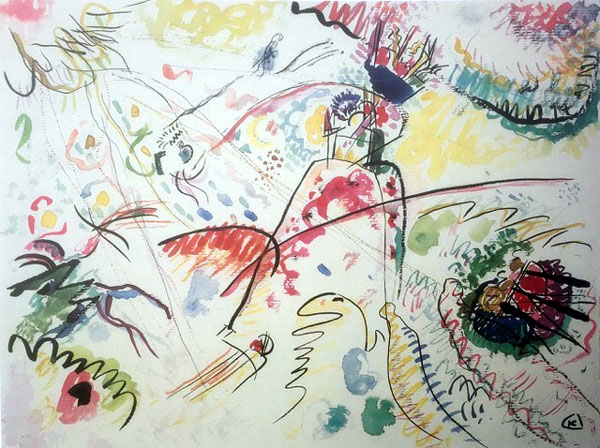
After the woodcuts I became acquainted with his paintings. It was the year
when he created "The landscape with towers" and "The picture with
houses." Van Gogh and Gauguin had prepared me beforehand, so these two
pictures did not astonish me. But I felt at once that Kandinsky went further
than they. What I felt was the fact of his absolutely honest attitude toward
his art, a complete absence of "bravado" or the desire for "épater" [to shock
]. At the same time I felt his unusual patience with, and understanding of,
other painters who were still interested in subject matter or who took some
other way. His patience, his intense desire to help, to explain, combined
with his outer peacefulness, created such an atmosphere that it turned all
the forces of those around him into an inner fire.
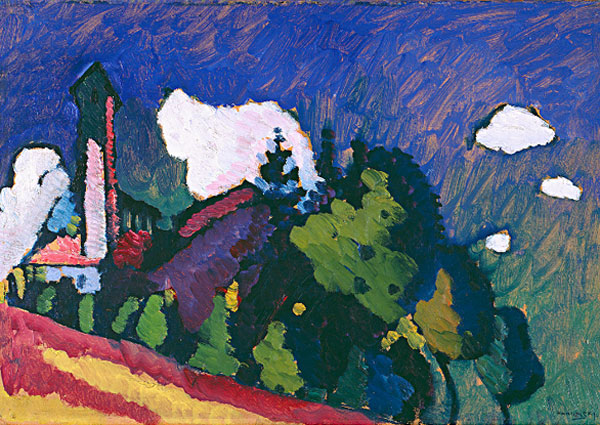
When Kandinsky began work on big canvases, those called by him
"Compositions," I could follow the gradual processes by which they were
brought to life. Usually a picture being worked on was turned to the wall
for a time, and later it was turned back so that you could look at it again. In
his first "Compositions" you could still see figures, knights, distinct towns
with towers, but already all else was color. Characteristic was the fact that I
myself didn't like realistic images any more, and in our talks we often
spoke about this. Kandinsky's full withdrawal from "the object" happened
several years later.
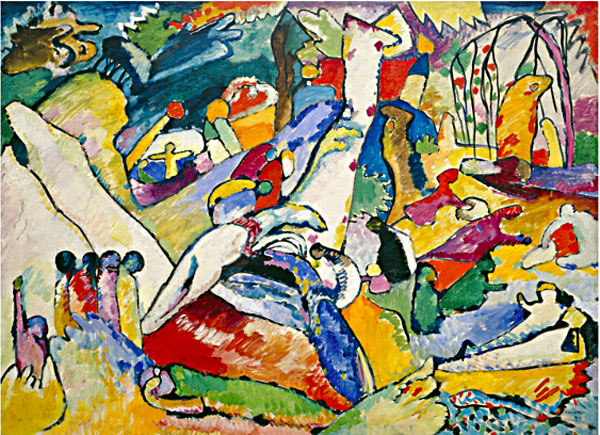
His penetration into a completely new region of abstract painting was slow
and organic in the gradual acknowledgement of the way he took. He was
not understood by everyone during those years. Even those near him and
paying him tribute were cold to his ideas at this time. It is true that times
were then different from now: Now everything is "permitted and
understood." But until 1914 was a period of great questions and of slowly
conquering the New. An honest artist carried always within him the
question "Is it permitted? Are these means admissible?" All means are
permitted, said Kandinsky, all, if it is necessary to express the inner sound.
He spoke very often about the inner sound. More concrete realization
of this was achieved in his work for stage which he called
"The Yellow Sound."
[Here, we have held back Hartmann's account of their work together on
Kandinsky's stage play, "The Yellow Sound," to share fully another time.
-Eds.]
The years spent in close spiritual association with Kandinsky have
naturally left me with a richness about which I would like to talk more to
those who did not know him. But time is short. Memories of talks with him,
of his views on his own art and art in general, memories of his lofty spirit
can be described best by his own words, "A spiritual wealth."
I will finish my recollection of Kandinsky with the scene when I saw him
for the last time, two days before his death. His wife had asked me to cheer
him up, and had left the room. I was alone before Kandinsky, who was
dying. He smiled at me, then went to sleep. I looked at him and at his
pictures which hung on the wall, pictures he loved most. One was from the
period of his first "Compositions," the period of some imaginary
catastrophes, and destructions corresponding to that level which in Hindu
philosophy is called the plane of suffering. They were painted during years
when no one could imagine that such catastrophes could take place, that
here, on the so-called physical plane, there would be such disasters, wars
and revolutions. Some people would not pay attention, but others would
see in these pictures a sort of foretelling.
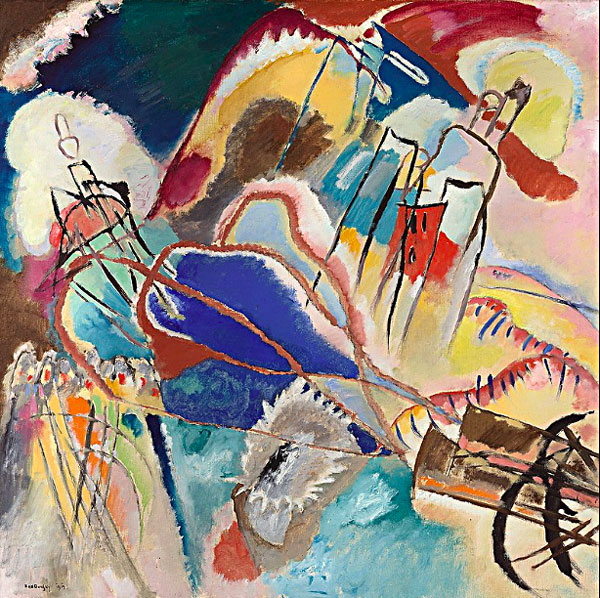
And then I looked at another picture, one from his last period—unearthly
blue space, in it correct geometrical figures, and over the whole reigned
peace, harmony, a kind of wonderful oneness in multiplicity. A quite
different, very high spiritual world. In Hindu philosophy, the enlightened
world of high Reason. Perhaps here also my friend Kandinsky had foreseen
the coming of a spiritual awakening, when the inner sound will be heard by
everyone.
* * *
Full information on the paintings, by Jelena
1. "Frühling / Printemps," No. 69, not dated, 1905, tempera, 10 7/8 x 13 1/4
inches. Kandinsky's own handlist: "69, Frühling (Wäsche)." Location:
Lenbachhaus Munich; till 1957 in Gabriele Münter's possession.
2. "Study for 'Small Pleasures'," 1913, watercolor and Indian Ink, 9 3/8 x 17
7/8 in. Centre Pompidou.
3. "Murnau—Landscape with Tower," 1908, oil/cardboard, 75,5 x 99,5 cm.
Centre Pompidou.
4. "Sketch for Composition II," 1910, oil/canvas, 97,5 x 131,2 cm. The
Solomon R. Guggenheim Museum.
Jelena's note: Compositions I, II and III were destroyed during WW I. So
this "Sketch for Composition II," 1910, is the closest we can get to knowing
them. This so-called "Sketch for Composition II" is in fact much more than
a sketch; it is a complete, large oil painting—very close to the black and
white photo that remains of the final Composition II. It is kept at the
Guggenheim Museum in New York.
5. "Improvisation 30 (Cannons)," 1913, oil/canvas, 110 x 110 cm. The Art
Institute of Chicago.
|